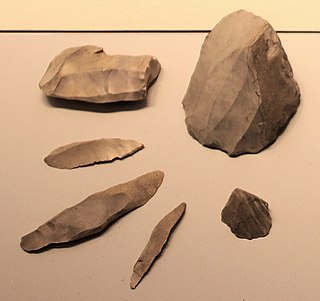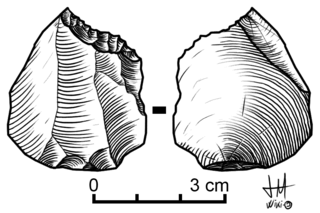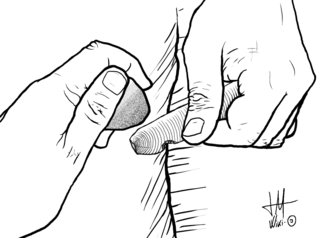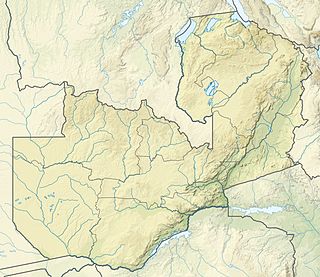
The Epipalaeolithic Near East designates the Epipalaeolithic in the prehistory of the Near East. It is the period after the Upper Palaeolithic and before the Neolithic, between approximately 20,000 and 10,000 years Before Present (BP). The people of the Epipalaeolithic were nomadic hunter-gatherers that generally lived in small, seasonal camps rather than permanent villages. They made sophisticated stone tools using microliths—small, finely-produced blades that were hafted in wooden implements—which are the primary means by which archaeologists recognise and classify Epipalaeolithic sites.

A microlith is a small stone tool usually made of flint or chert and typically a centimetre or so in length and half a centimetre wide. They were made by humans from around 35,000 to 3,000 years ago, across Europe, Africa, Asia and Australia. The microliths were used in spear points and arrowheads.

Maglemosian is the name given to a culture of the early Mesolithic period in Northern Europe. In Scandinavia, the culture was succeeded by the Kongemose culture and Tardenoisian culture.
The Magosian is the name given by archaeologists to an industry found in southern and eastern Africa. It dates to between 10,000 and 6,000 years BC and is distinguished from its predecessors by the use of microliths and small blades.

The Azilian is a name given by archaeologists to an industry in the Franco-Cantabrian region of northern Spain and southern France. It probably dates to the period of the Allerød Oscillation around 14,000 years ago (uncalibrated) and followed the Magdalenian culture. It can be classified as part of the Epipaleolithic or the Mesolithic periods, or of both.
The Tardenoisian is an archaeological culture of the Mesolithic/Epipaleolithic period from northern France and Belgium. Similar cultures are known further east in central Europe, parts of Britain. and west across Spain. It is named after the type site at Fère-en-Tardenois in the Tardenois region in France, where E. Taté first discovered its characteristic artifacts in 1885.

A microburin is a characteristic waste product from manufacture of lithic tools — sometimes confused with an authentic burin — which is characteristic of the Mesolithic, but which has been recorded from the end of the Upper Paleolithic until the Calcolithic. This type of lithic artifact was first named by Henri Breuil who defined it as "a type of angular, smooth, with a terminal retouch in the form of a small notch". Breuil initially thought that the microburins had a functional use as a type of microlithic burin. However, he later came to realize that the manufacturing technique was different from that of the burin and that they could be waste products from the manufacture of microliths, but they may have occasionally been reused for a useful purpose.

The Kebaran or Kebarian culture, also known as the Early Near East Epipalaeolithic, was an archaeological culture in the eastern Mediterranean area, named after its type site, Kebara Cave south of Haifa. The Kebaran were a highly mobile nomadic population, composed of hunters and gatherers in the Levant and Sinai areas who used microlithic tools.

Fa Hien Cave, also Pahiyangala Cave, is situated in the district of Kalutara, Western Province, Sri Lanka and according to a rural legend, named after an alleged resident during historical times, namely Buddhist monk Faxian. However, there is no archaeological or historical evidence to support this legend. Nonetheless, the site is of archaeological significance as Late Pleistocene human fossilized skeletal remains were discovered in the cave's sediments during excavations in the 1960s, the 1980s and in 2013.

Es-Skhul is a prehistoric cave site situated 20 km (12.4 mi) south of the city of Haifa, Israel, and around 3 km (1.9 mi) from the Mediterranean Sea. The site was first excavated by Dorothy Garrod during summer of 1928. The excavation revealed the first evidence of the late Epipaleolithic Natufian culture, characterized by the presence of numerous microlith stone tools, human burials and ground stone tools. Skhul also represents an area where Neanderthals - possibly present in the region from 200,000 to 45,000 years ago - may have lived alongside these humans dating to 100,000 years ago. The cave also has Middle Palaeolithic layers.
Zarzian culture is an archaeological culture of late Paleolithic and Mesolithic in Southwest Asia.

Belbaşı is a cave and a late Paleolithic/Mesolithic site in southern Turkey, located southwest of Antalya.
Balangoda Man refers to hominins from Sri Lanka's late Quaternary period. The term was initially coined to refer to anatomically modern Homo sapiens from sites near Balangoda that were responsible for the island's Mesolithic 'Balangoda Culture'. The earliest evidence of Balangoda Man from archaeological sequences at caves and other sites dates back to 38,000 BP, and from excavated skeletal remains to 30,000 BP, which is also the earliest reliably dated record of anatomically modern humans in South Asia. Cultural remains discovered alongside the skeletal fragments include geometric microliths dating to 28,500 BP, which together with some sites in Africa is the earliest record of such stone tools.

The microburin technique is a special procedure for cutting up lithic blades which yields fragments that can be used in the manufacture of utensils. The usable fragments are basically geometric microliths. This technique has been recorded through the Old World, from at least the Mesolithic. It has also been recorded from the later phases of the Upper Paleolithic, as triangular and trapeze shaped microliths have been found from the end of the French Magdalenian although they are very rare. The microburin blow technique has not been found, at present, in the New World. The technique consists of taking a blade and placing its upper end against a support with a sharp edge. A notch is then made and enlarged using light blows or by pressing the edge of the piece against the angled edge of the support. The notch is enlarged until the lithic blade snaps with a gentle but positive action (flection).

The Rop rock shelter is an archaeological site on the Jos Plateau of Nigeria. There are two layers containing artifacts. The first holds large scrapers and backed crescent-shaped stone tools. The later (upper) layer is about 2000 years old, and contains backed microlithic tools and pottery. The shelter is about 50km south of Jos.

Jabal es Saaïdé, Jabal es Saaide, Jabal as Sa`idah, Jabal as Sa`īdah, Jebal Saaidé, Jebel Saaidé or Jabal Saaidé is a Mountain in Lebanon near the inhabited village of Saaïdé, approximately 12 kilometres (7.5 mi) northeast of Baalbek, Lebanon.

The Caves of Nahal Me’arot / Wadi el-Mughara, named here by the Hebrew and Arabic name of the valley where they are located, are a UNESCO Site of Human Evolution in the Carmel mountain range near Haifa in northern Israel.

Ganeshwar is a village in Neem-Ka-Thana Tehsil (Mandal) in the Sikar District of the Indian state of Rajasthan. Ganeshwar is 7.9 kilometres (4.9 mi) distance from Neem-Ka- Thana town, 66.4 kilometres (41.3 mi) from Sikar city and 83 kilometres (52 mi) from Jaipur. Excavations in the area revealed the remains of a 4,000-year-old civilization.

The Kalemba Rockshelter is an archaeology site located in eastern Zambia, at coordinates 14°7 S and 32°3 E. Local tradition recalls the use of the rock shelter as a refuge during the time of Ngoni raiding in the 19th century. The site is known for various rock paintings as well as advanced microlithic use.

The Levantine Aurignacian is an Upper Paleolithic culture of the Near-Eastern Levant. It was named so because of the similarity of stone tools with the Aurignacian culture in Europe. The Levantine Aurignacian used to be called Lower and Upper Antelian in old sources, from the site of Wadi Antelias in Lebanon.














